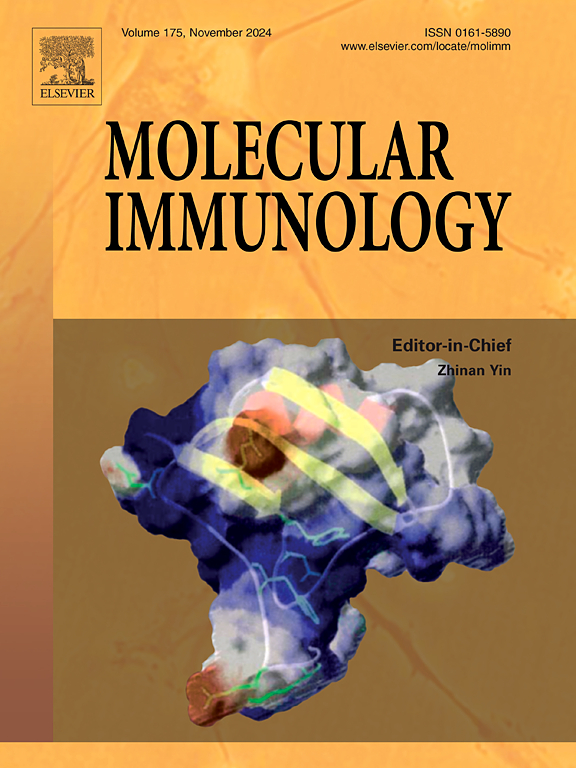Drice negatively regulates cellular and humoral immunity of Drosophila melanogaster
IF 3
3区 医学
Q2 BIOCHEMISTRY & MOLECULAR BIOLOGY
引用次数: 0
Abstract
The innate immune response is a double-edged sword in insects, comprising the humoral and cellular mechanisms to fight and eliminate pathogens. The humoral response is achieved by the production of antimicrobial peptides, which are secreted in the hemolymph. The cellular responses are mediated by phagocytosis, encapsulation and melanization. Though the fat bodies are the primary immune tissues in Drosophila, secreting AMPs, the Malpighian tubules are also autonomous immune organs that constitutively secrete AMPs at basal levels, which increases after infection. Here we provide evidence to show that the caspase 3 homolog in Drosophila, Drice, negatively regulates both, cellular as well as humoral immunity. Depletion of Drice leads to the increased expression of transcription factor Relish, which enhances the expression of certain AMPs regulated by the IMD pathway. In the absence of Drice, both the Ecdysone receptor- B1 and Broad-core (Br-C) are also upregulated which are upstream regulators of the IMD pathway. The increase in crystal cells clearly indicates Drice to be a negative regulator of this form of cellular immunity. Collectively our findings suggest the role of Drice in the immune regulation of Drosophila melanogaster, and these results will add to the growing understanding of diverse roles of caspases in immune regulation.
price负向调节果蝇的细胞免疫和体液免疫
昆虫的先天免疫反应是一把双刃剑,包括体液和细胞机制来对抗和消灭病原体。体液反应是通过产生在血淋巴中分泌的抗菌肽来实现的。细胞反应由吞噬、包被和黑化介导。虽然脂肪体是果蝇的主要免疫组织,分泌AMPs,但马尔比氏小管也是自主免疫器官,在基础水平上组成性地分泌AMPs,在感染后增加。在这里,我们提供的证据表明,在果蝇的caspase 3同源物,水稻,负调控,细胞和体液免疫。price的缺失导致转录因子flavor的表达增加,从而增强了受IMD途径调节的某些amp的表达。在没有price的情况下,Ecdysone受体- B1和Broad-core (Br-C)也上调,它们是IMD途径的上游调节因子。晶体细胞的增加清楚地表明,普莱斯是这种细胞免疫形式的负调节因子。总的来说,我们的研究结果提示了Drice在果蝇免疫调节中的作用,这些结果将增加对半胱天冬酶在免疫调节中的多种作用的理解。
本文章由计算机程序翻译,如有差异,请以英文原文为准。
求助全文
约1分钟内获得全文
求助全文
来源期刊

Molecular immunology
医学-免疫学
CiteScore
6.90
自引率
2.80%
发文量
324
审稿时长
50 days
期刊介绍:
Molecular Immunology publishes original articles, reviews and commentaries on all areas of immunology, with a particular focus on description of cellular, biochemical or genetic mechanisms underlying immunological phenomena. Studies on all model organisms, from invertebrates to humans, are suitable. Examples include, but are not restricted to:
Infection, autoimmunity, transplantation, immunodeficiencies, inflammation and tumor immunology
Mechanisms of induction, regulation and termination of innate and adaptive immunity
Intercellular communication, cooperation and regulation
Intracellular mechanisms of immunity (endocytosis, protein trafficking, pathogen recognition, antigen presentation, etc)
Mechanisms of action of the cells and molecules of the immune system
Structural analysis
Development of the immune system
Comparative immunology and evolution of the immune system
"Omics" studies and bioinformatics
Vaccines, biotechnology and therapeutic manipulation of the immune system (therapeutic antibodies, cytokines, cellular therapies, etc)
Technical developments.
 求助内容:
求助内容: 应助结果提醒方式:
应助结果提醒方式:


